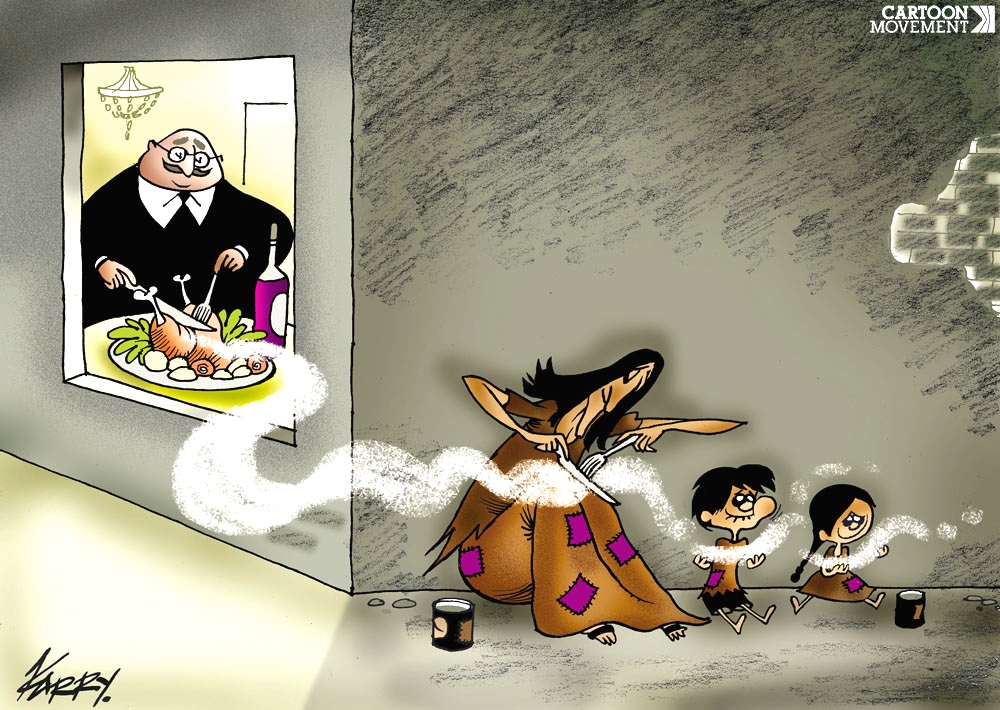
How government policies worsen the nation’s income and wealth disparities comes into sharp focus in a new government report on capital gains. The short story: Investing is gaining and work declining as sources of income.
Capital gains come from selling assets such as stocks, real estate and businesses. Property owned for more than a year is taxed at lower rates than wages and in some cases is tax-free.
Although capital gains are growing — an indication that national wealth is growing — far fewer capital gains are going to the vast majority, while those at the absolute top of the economy are enjoying vastly more. This trend, as well as other official data, suggests that wealth is piling up at the top and that a narrowing number of Americans are wealth holders.
Larger Pie, Smaller Slice
These findings emerge from a new report by the Statistics of Income branch of the IRS that examined a large set of taxpayers over nine years. I have reanalyzed the data, adjusted for inflation, and then compared similar, but not identical, data for 2012, the year with the latest available numbers.
To understand recent changes in capital gains, think of a pie made from the money received when stocks and other assets are sold for a profit. Call it a capital gains pie.
Now imagine we set down the 1999 and 2007 capital gains pies side by side to see how they were sliced up and handed out to four Americans sitting at the dinner table, who represent four different income classes.
The good news is that the 2007 pie is 40 percent larger than the 1999 pie. But it’s also important to consider the size of the various slices.
The smallest slice from both pies goes to the vast majority of Americans, roughly the bottom 90 percent, whose total income in both years was less than $100,000. In 1999 they got 13.9 percent of the pie, but in 2007 just 5.3 percent.
That was such a dramatic decrease that even though the pie was much larger in 2007, that year’s pie slice contained only slightly more than half the dollars of the 1999 slice, $91 million reduced to $49 million. In other words, the bottom 90 percent took a huge capital gains hit, despite the overall increase in wealth.
Next are the slices going to the roughly one in eight Americans making between $100,000 and $1 million. Their slice shrank from 35.5 percent to 28.6 percent, but the dollars received grew by 13 percent, because the pie got bigger.
Next come the small number of Americans, roughly one in 400, who made between $1 million and $10 million in both years. Their slice of pie also shrank, from just over 28 percent to just under 24 percent. But the total dollars in their slice went up by 17 percent.
And what of the top group, the slightly more than 18,000 households with total income of $10 million or more in both years? Their slice doubled to more than 42 percent of the pie. And because the pie was also bigger, their cash from capital gains in 2007 was 2.6 times greater than in 1999.
So in 1999 the already very rich made almost $146 billion from capital gains, but eight years later they made more than $388 billion.
Wealth was already highly concentrated in America before the 2008 financial crisis, especially financial wealth — stocks, bonds, the cash value of life insurance policies and cash. The Great Recession was a disaster for those who were forced to sell assets due to unemployment, but a grand opportunity for those with the money to buy stocks and other assets at fire sale prices. Since Barack Obama took office five years ago the stock market has more than doubled, while average incomes have fallen.
The Role of Policy
So are these trends due simply to the luck of the free market? No, in fact, government polices have played an important role in generating these grossly unequal outcomes.
First, tax cuts: One in 1,000 Americans, roughly those making more than $2 million annually, enjoyed 12.5 percent of the tax cuts championed by President George W. Bush. When that’s combined with previous tax cuts under Presidents Johnson, Reagan and Clinton, the top 400 taxpayers in 2006 enjoyed a 60 percent reduction in their total tax burden compared with 1961, my analysis of a different set of IRS statistics shows.
Second, wages hardly grew during the years 1999 to 2007 — or since. Adjusted for inflation, the average wage reported on tax returns in 2007 was only 1.7 percent more than in 1999. That works out to an average annual pay increase of a nickel an hour, not that anyone would notice such a tiny sum — less than $2 per week.
In the next five years, to 2012, the average wages on tax returns remained essentially flat, up $55 compared with 2007. That’s the equivalent of getting a raise each year of about half a penny per hour — less than 20 cents per week.
When wages do not grow but the cost of living rises, people have a reduced capacity to save and invest. Those among the less well off who had saved only to join the ranks of the long-term unemployed have had to sell some or all of their investments to those who are better off.
Among the vast majority a dwindling share of people report any capital gains. In 1999 it was more than 9 percent of taxpayers, but in 2012 it was under 5 percent.
The decimation of unions, enabled by government policies that make organizing extremely difficult, is a major factor in stagnant wages. Moving factory work offshore has added to the downward pressure on wages. Now some white-collar workers are feeling the effects, since almost any job done at a computer can be moved to a low-wage country such as India.
Third, the massive growth of subsidies to business tends to increase the value of companies that get such deals; to enable profit taking, dividends and oversized compensation; to weaken competitors not afforded these gifts (perhaps because of lack of lobbying power and campaign contributions); and to burden taxpayers generally. Many of these subsidies come from state and local governments, virtually all of which inordinately burden those down the income ladder more than the well off, because of regressive levies such as sales taxes.
Holding down wages has increased corporate profits, which have soared to heights never before seen, at least since the government started issuing consistent statistical measures in the late 1920s.
For the bottom 90 percent, roughly the same group making under $100,000 that the IRS studied, total income in 2012 was $31,000 in 2012, down almost $5,400 — or about 15 percent — compared with 1999, analysis of tax data by economists Emmanuel Saez and Thomas Piketty shows.
However, incomes soared for the top 1 percent of the top 1 percent — approximately 16,000 households, or a slightly smaller group than the 18,000 high earners in the IRS study. This group averaged almost $31 million in 2012, up $5 million compared with 1999.
In a representative democracy we choose our leaders, who in turn set policy. A major reason we are not getting laws and regulations that support the vast majority of Americans is that members of Congress and candidates for President must raise money from wealthy donors, who in return for their largesse want policies bent in their favor.
The Supreme Court’s ruling yesterday in McCutcheon v. FEC is probably not the last to overturn limits on campaign giving that were adopted after the Watergate scandal revealed the corrupting influence of big money. As big money’s influence grows due to the high court’s decision we can expect those slices of pie to be recut again and again with fatter slices for the political donor class and thinner slices for everyone else.
3 WAYS TO SHOW YOUR SUPPORT
- Log in to post comments












